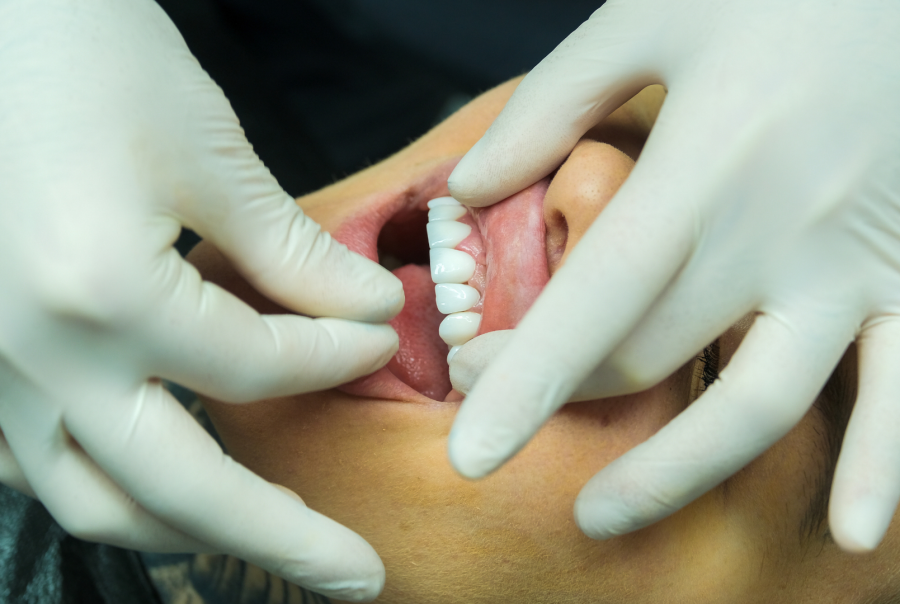Get information about Dental Bridge with the explanation of specialist dentist Egemen Ozdemir.
Dental Bridge

Dental Bridge, Prime Dental Turkey.
Dental bridges are fixed dental prostheses used to close gaps caused by missing teeth.
Dental bridges are fixed dental prostheses used to close gaps caused by missing teeth. They are dental prostheses that are generally supported by reducing the teeth on both sides of the gap area. It is more preferred when there is not enough bone for the implant or when it is desired to finish the treatment with a single trip. It is produced from zirconium veneers. Since they are fixed prostheses, they are comfortable to use and perform the chewing function easily. Their lifespan is about ten years like other veneers.
A dental bridge is an artificial tooth or teeth placed over neighboring teeth when one or more teeth are missing. The bridge is supported by crowns placed on the lateral teeth and these crowns keep the bridge strong and stable. It is used for both aesthetic and functional purposes. It replaces lost teeth, restores the strength of teeth after tooth decay or fractures, performs chewing function properly, and can also help maintain correct alignment of teeth.
Dental bridges can be made of different materials. Traditional dental bridges can be made of porcelain, metal or ceramic materials. Today, zirconium dental bridges, which are a more aesthetic option, are also used. It is specially designed and sized by dentists. The treatment process is usually two-stage and in the first stage, the teeth on the sides are prepared and a dental bridge is made according to the measurements taken. In the second stage, the bridge is placed and followed over the teeth for several months.
Benefits of a dental bridge
A dental bridge can provide several benefits if one or more teeth are lost. Some benefits are:
- 1. Aesthetics: The dental bridge ensures the correct alignment of the teeth, providing an aesthetic appearance instead of decayed or broken teeth.
- Functionality: The dental bridge replaces the lost teeth and restores the chewing, speaking and digesting functions of the teeth.
- Protective: The dental bridge can prevent teeth from being worn and broken, helping to maintain the correct alignment of teeth.
- Ease of Use: Dental bridges can be used like natural teeth without the need for a difficult process such as insertion and removal.
- Suitability: Since dental bridges can be made of different materials, they can be designed to suit patients’ needs and budgets.
- Fast and Effective: Dental bridges can be applied more quickly and require less time for the patient compared to other restorative procedures.
- Dental and Jaw Bone Health: Dental bridges can prevent jaw bone loss caused by tooth deficiency.
Dental bridges can be made of different materials and have different designs. The most commonly used dental bridges are:
- Conventional dental bridge: The traditional dental bridge, which is a metal-supported porcelain crown, is placed on top of the teeth and screwed to the lateral teeth. Traditional dental bridges are durable and long-lasting, but are aesthetically disadvantageous due to their metal infrastructure.
- Winged dental bridge: A winged dental bridge is a ceramic dental bridge supported by wings placed on the lateral teeth. Winged dental bridges are a more aesthetic option compared to traditional metal-supported dental bridges.
- Maryland dental bridge: Maryland dental bridge is made of ceramic or porcelain, not metal backing. It is attached with an adhesive behind the teeth on the sides. Maryland dental bridges are less invasive and require minimal tooth preparation. However, such bridges may not provide adequate support and may be short-lived.
- Zirconium dental bridge: Zirconium dental bridges have become a popular option in recent years. Zirconium has a color similar to tooth color and is a more aesthetic option. In addition, it is durable, long-lasting and does not cause allergic reactions.Dental bridges offer a range of options that can be made of different materials and come in different designs. After evaluating the condition of your teeth, your dentist will select the most suitable dental bridge option for you.
Which Materials Can Be Preferred?
The most commonly used materials are:
- Porcelain: Porcelain is a frequently used material for dental bridges. Porcelain is an aesthetic option as it has a color similar to tooth color.
- Ceramic: Ceramic is another popular material for dental bridges. Ceramic has a tooth-like color like porcelain and is durable.
- Metal: Metal-supported dental bridges are usually made of metals such as gold, silver, or palladium. Metal dental bridges are durable and long-lasting, but they are aesthetically disadvantageous.
- Zirconium: Zirconium is an aesthetic option because it has a similar color to the tooth. In addition, it is durable, long-lasting and does not cause allergic reactions.
Your dentist will determine which material should be preferred according to the condition and needs of your teeth. The material selection will help you rebuild your teeth in a natural looking and durable way.
How is bridge treatment applied?
Dental bridge treatment is usually a two-step process and includes the following steps:
- Preparation of Teeth: Before the dental bridge treatment, your dentist will prepare the teeth to which the treatment will be applied. The preparation process may include the size, shape and shaping of the teeth. The teeth are cut and shaped up to the gingival level. This will give your teeth enough room to fit the bridge.
- Impressions: Your dentist will take measurements of the prepared teeth. These dimensions will be used to construct the dental bridge in a special laboratory setting. Your dentist may place a temporary bridge on your teeth during impressions.
- Bridge Application: When the bridge is completed, your dentist will put the bridge in place using a special adhesive on your teeth. The bridge is harmonized with the gums and fixed with crowns placed on the lateral teeth.
Dental bridge treatment is important for oral hygiene. Dental bridges can be cleaned with regular brushing and flossing. Also, going to your dentist for regular checkups will help your bridges last longer and protect your oral health.
Cleaning and maintenance of dental bridges
Dental bridges are a restoration method used to replace lost teeth. Bridges are used for aesthetic and functional purposes and require proper care and cleaning for long-term use.
Dental bridges can be brushed using a toothbrush and toothpaste. Brushing should cover around and under bridges. The use of dental floss is also important for cleaning the bridge area under the gum line between the teeth.
Also, regular dental checkups help keep dental bridges healthy and long lasting. The dentist will make sure that the bridges are cleaned properly and will recommend any necessary treatment.
Proper care and cleaning of dental bridges is important for long-term use, keeping your teeth and bridges healthy and clean.
Dental Bridge with Questions and Answers
How long do tooth bridges last? How long do dental bridges last?
Dental bridges can last at least five to seven years. With good oral hygiene and regular professional cleanings, the bridge may last more than 10 years.
Is dental bridge painful?
The procedure used to put the dental bridge in your mouth is relatively easy and pain-free.
Do teeth bridges fall out?
Dental bridges are durable restorations; they typically last for 10 years or longer before replacement becomes necessary.
Egemen Ozdemir
He was born in Edirne in 1986. After completing his primary education at Edirne Şükrü Paşa Primary School, he finished his secondary education at Edirne Anatolian High School in 2001. He then attended Edirne Science High School from 2001 to 2004. He graduated from the Ege University Faculty of Dentistry, where he excelled in his studies.
Throughout his career, he has developed expertise in the field of aesthetic dentistry by participating in numerous courses, congresses, and symposiums. Before joining Prime Dental Clinic, he spent nine years working as a dentist and manager in various clinics in Izmir.










